Installation and Configuration of the Lite Edition (Single-Tier) ODBC Driver for Oracle 11g & 12c Data Sources, for Mac OS X
Review Preinstallation Documentation: Pre-Installation Requirements
Installation
- The Lite Edition (Single-Tier) ODBC Drivers for Oracle 11g & 12c for Mac OS X are distributed in a single disk image (.dmg) file, which contains a Macintosh Installer mpg.
This documentation assume Oracle 12c is in use, but exactly the same applies for Oracle 11g.
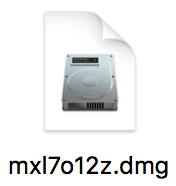
- Double-click the mpkg to start the installation process.
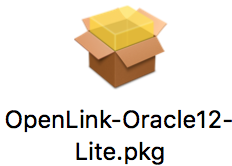
- The installer will display a Welcome message.
Click "Continue."
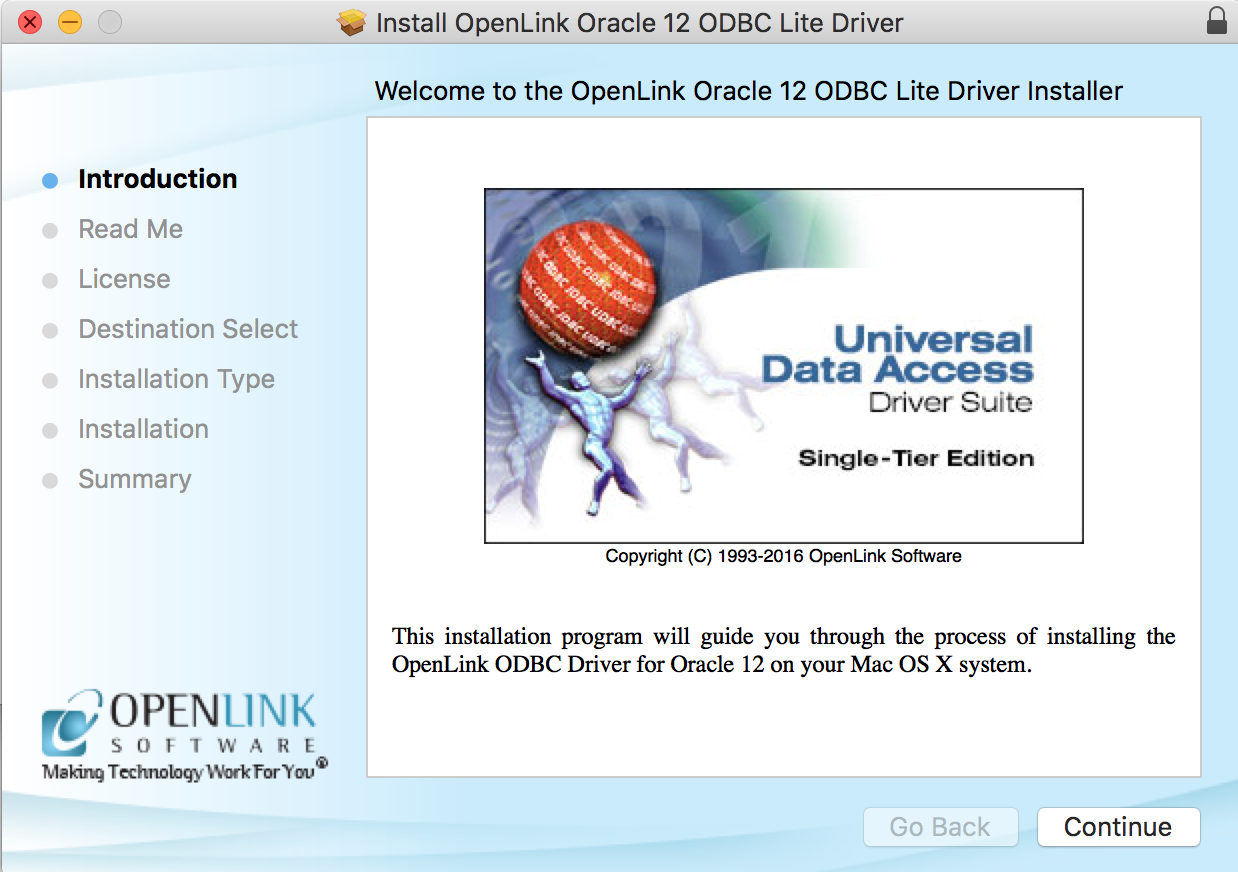
- The next screen will display the Read Me file, including any last- minute updates to these documents.
Please read carefully and click "Continue" when finished.
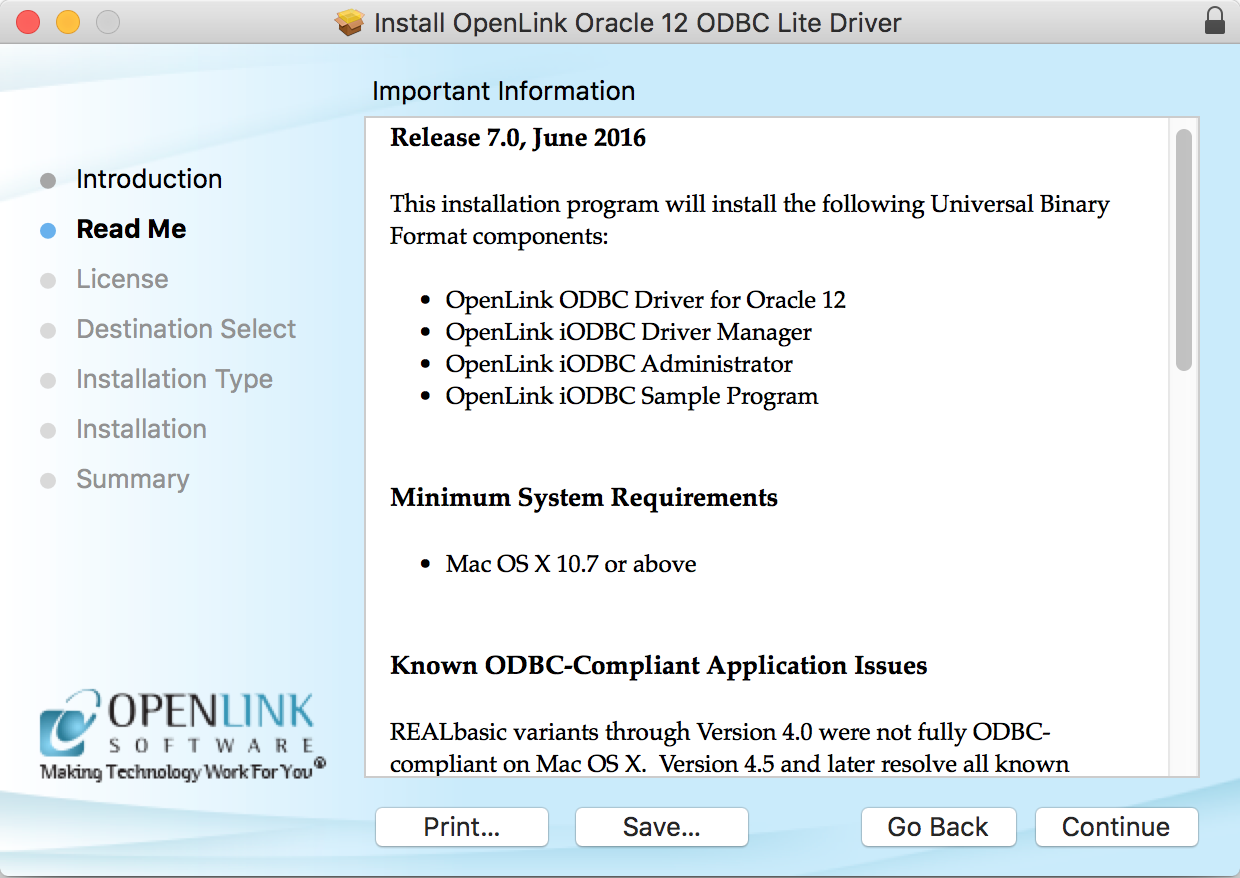
- The next screen will display the License Agreement for the
OpenLink Single-Tier Driver for ODBC. Please read and click "Continue."
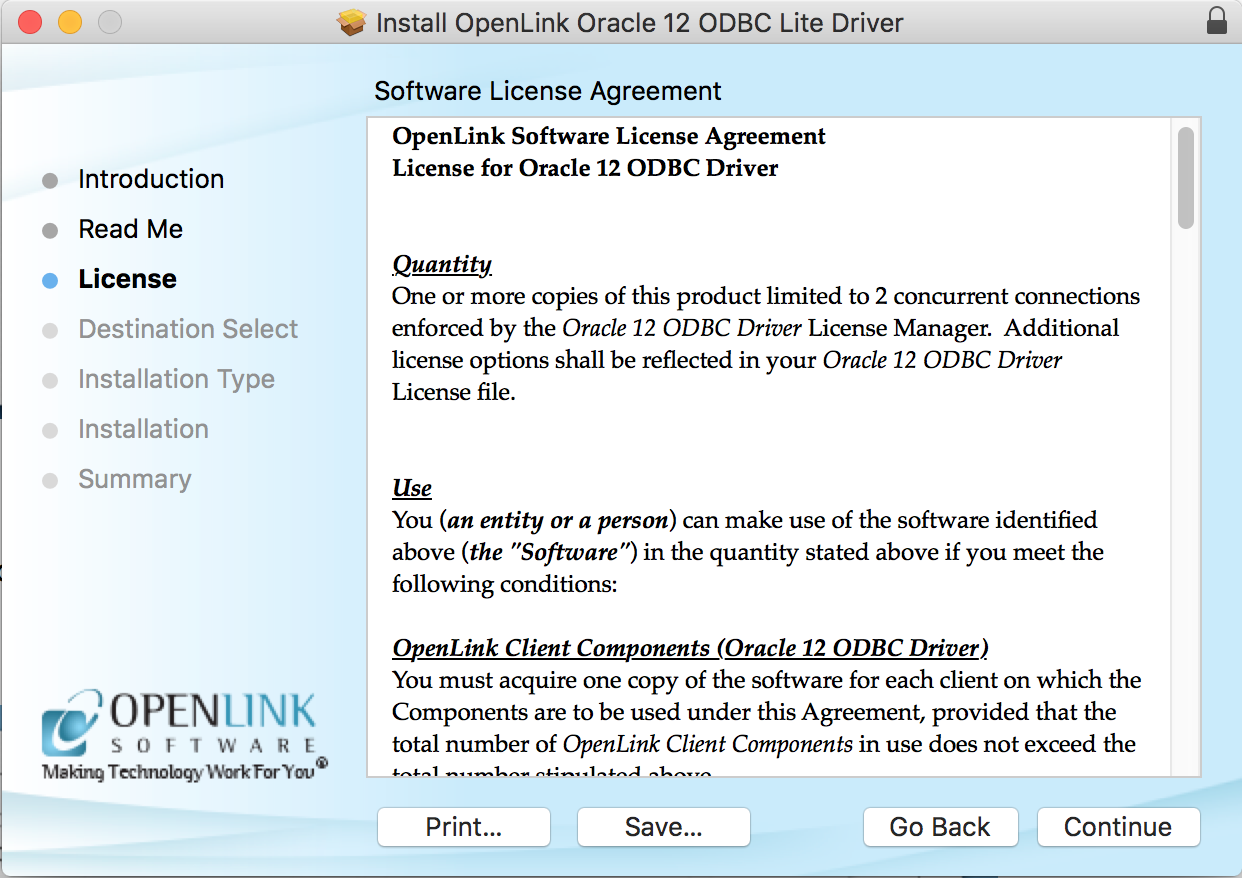
- You will be prompted to "Agree" to continue the installation or "Disagree" to abort.
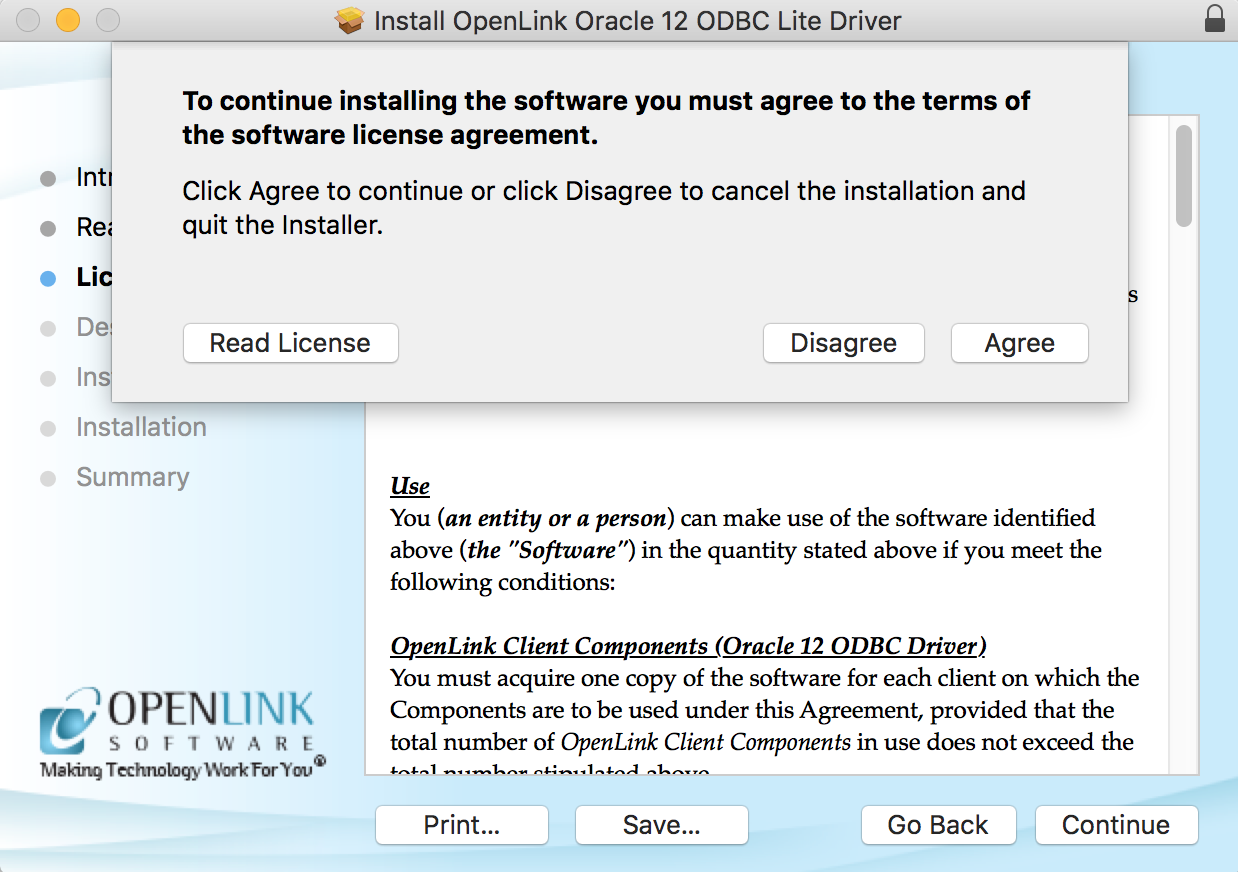
- You will be asked to select a Destination Volume.
Generally, this should be your Mac OS X boot volume.
Click on the desired disk icon and then click "Continue."
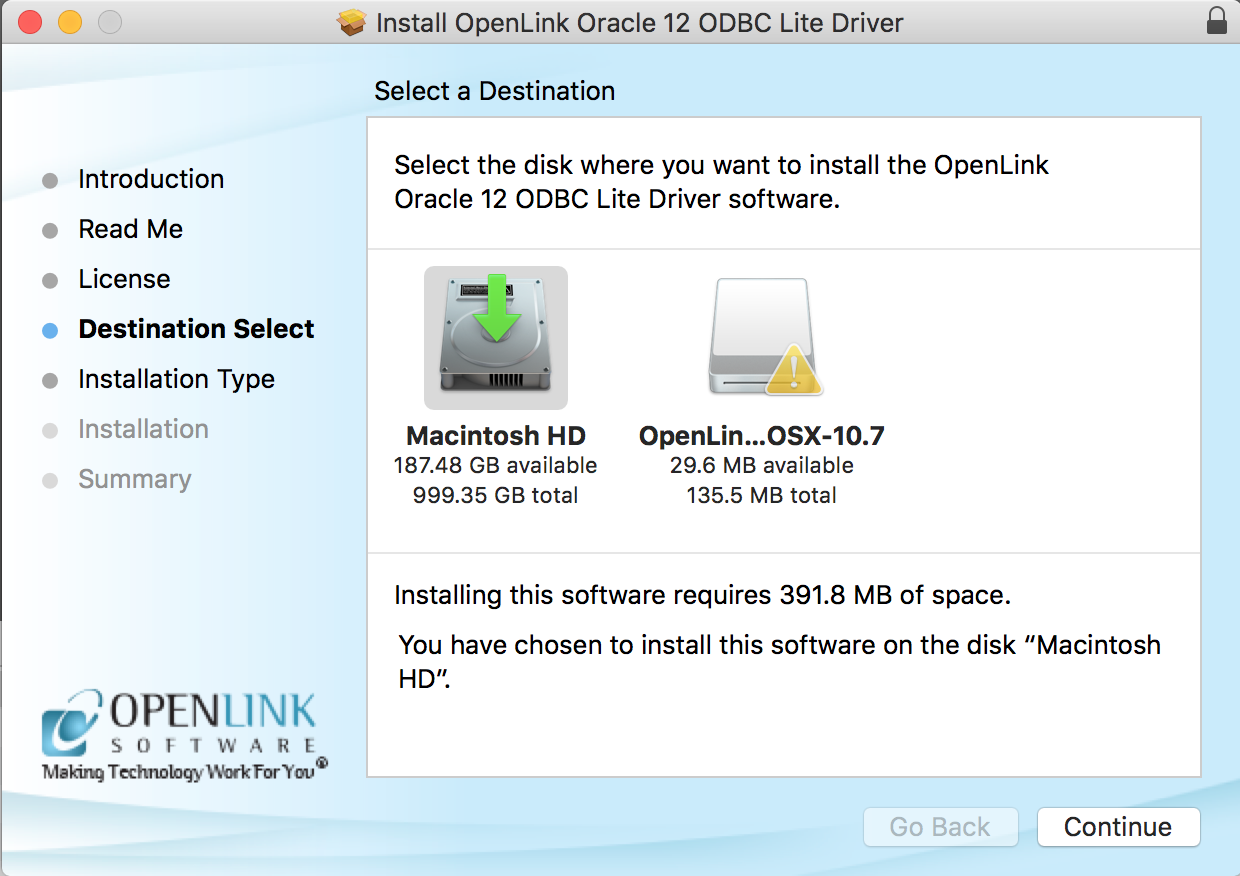
- You may now choose the Easy Install, or if you are an experienced user, you may Customize which components are installed.
OpenLink generally recommends the Easy Install.
- If you have installed
OpenLink or iODBC components in the past, click "Upgrade" to continue; otherwise, click "Install."
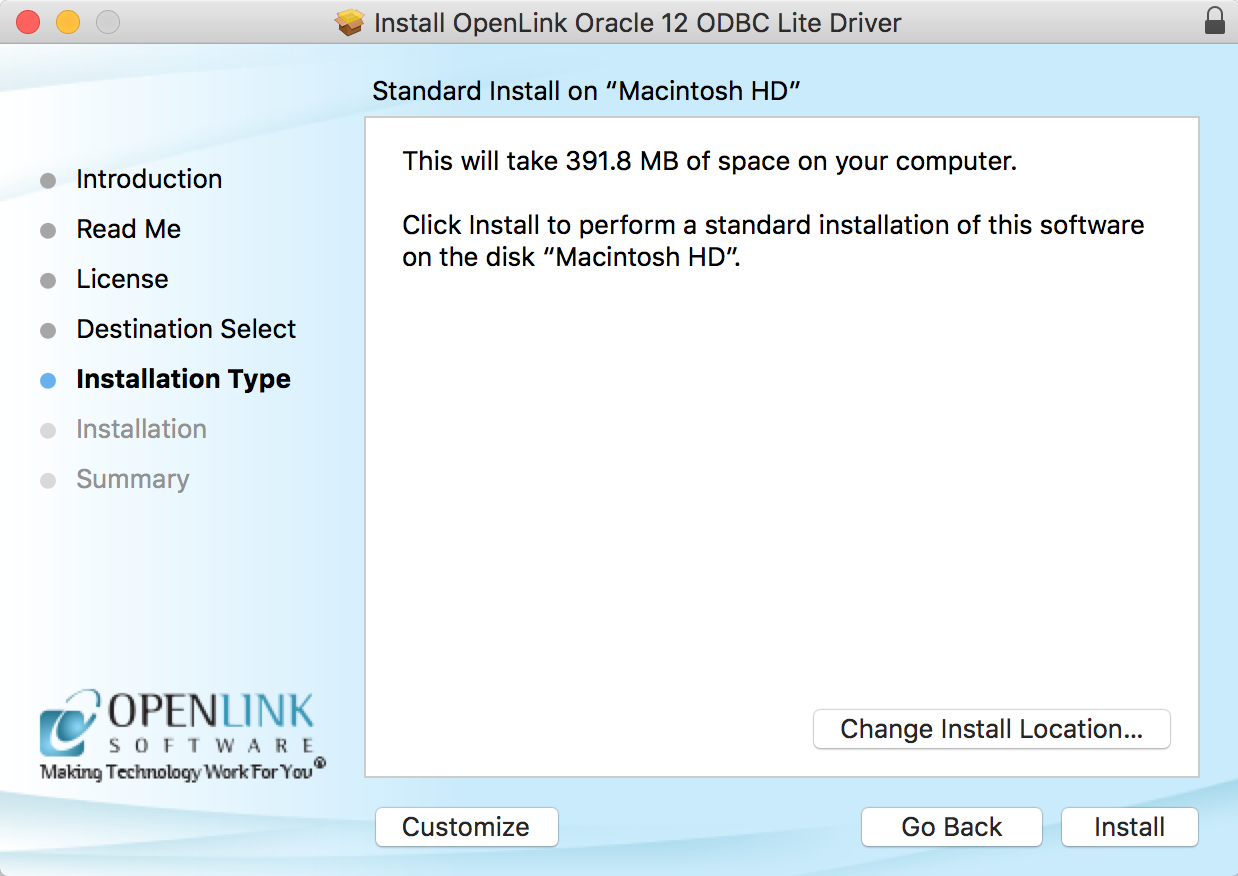
- If you chose the custom option, select which of the following components to install.
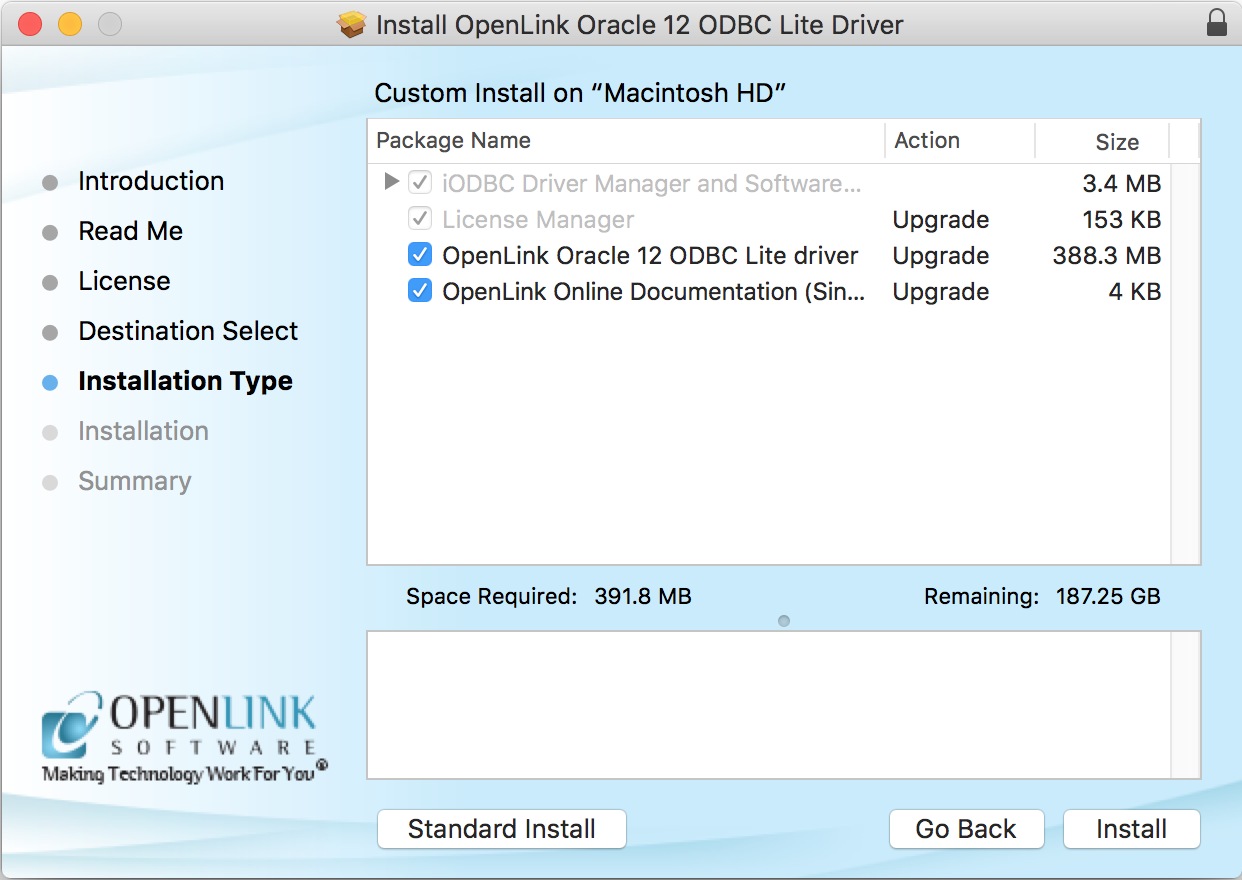
- You must have an Administration username and password to install the
OpenLink driver. Enter your Mac OS X Username and Password.
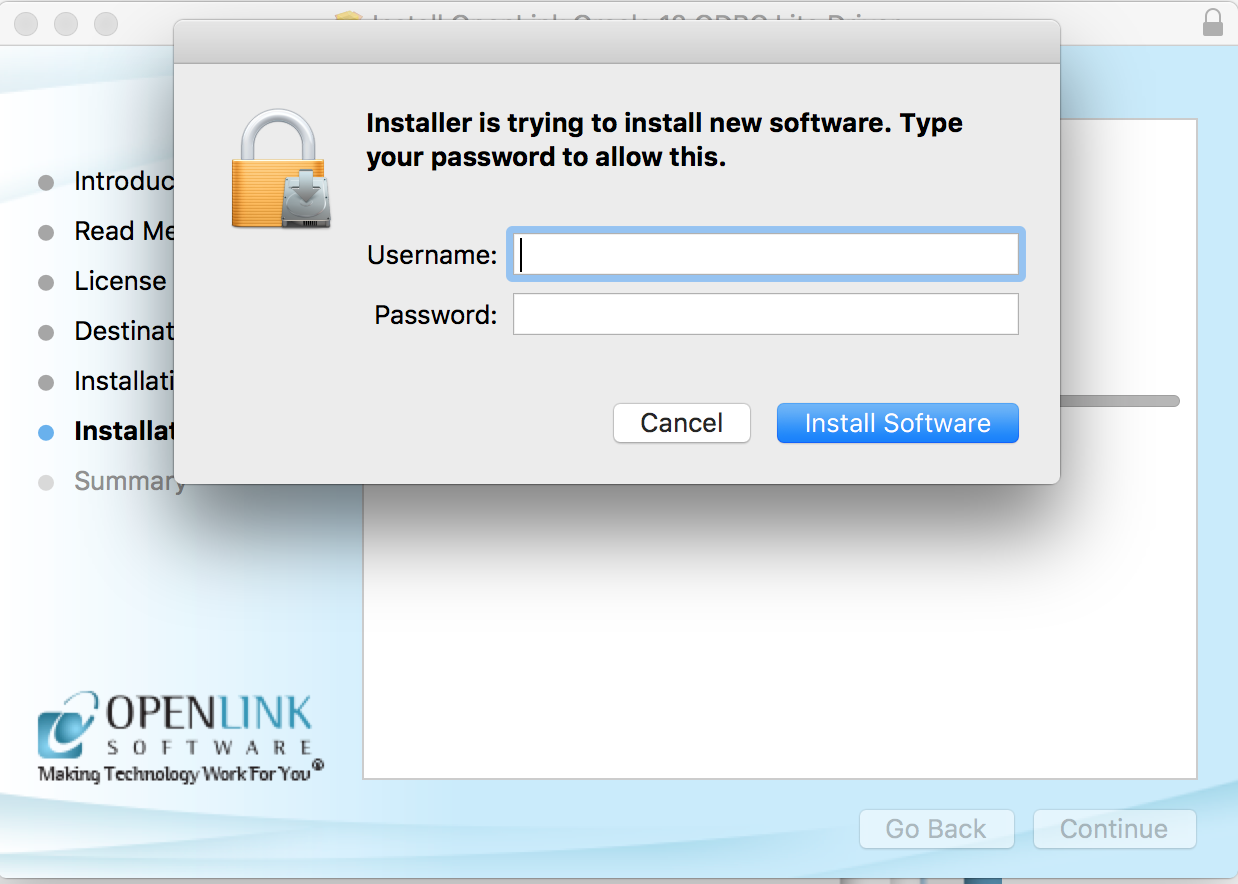
- You will be shown a graphical progress bar as the Installation progresses, followed by System Optimization.
- After the driver has been installed, you will be prompted to locate a license file.
NOTE -- If a correctly named file already exists in $OPL_LICENSE_DIR, /Library/Application Support/OpenLink/Licenses/, you will not see this dialog. If the existing file is not valid (evaluation has expired, it's for a different OS, it permits insufficient processor cores, etc.), you will need to manually apply a valid license file after installation is completed.
NOTE -- In some environments, this dialog may be hidden by the Installer.app or other windows on your Mac. Please minimize, hide, and/or move windows until you can see and act on this dialog. If you do not answer this dialog, the installation will not complete properly, and the driver will not function as desired.

- If a license file already exists on the machine, select the 'use existing' option.
(Previously generated license files may be re-downloaded from your ODS-Briefcase data space.)
- If you need to obtain a new trial or permanent license file, select the 'try or buy' option, which will load a relevant web page from which you can obtain a license file.
- If a license file already exists on the machine, select the 'use existing' option.
(Previously generated license files may be re-downloaded from your ODS-Briefcase data space.)
- When the process is complete, you will be told that the software was successfully installed.
Click "Close" and your new database driver for ODBC is ready for use.
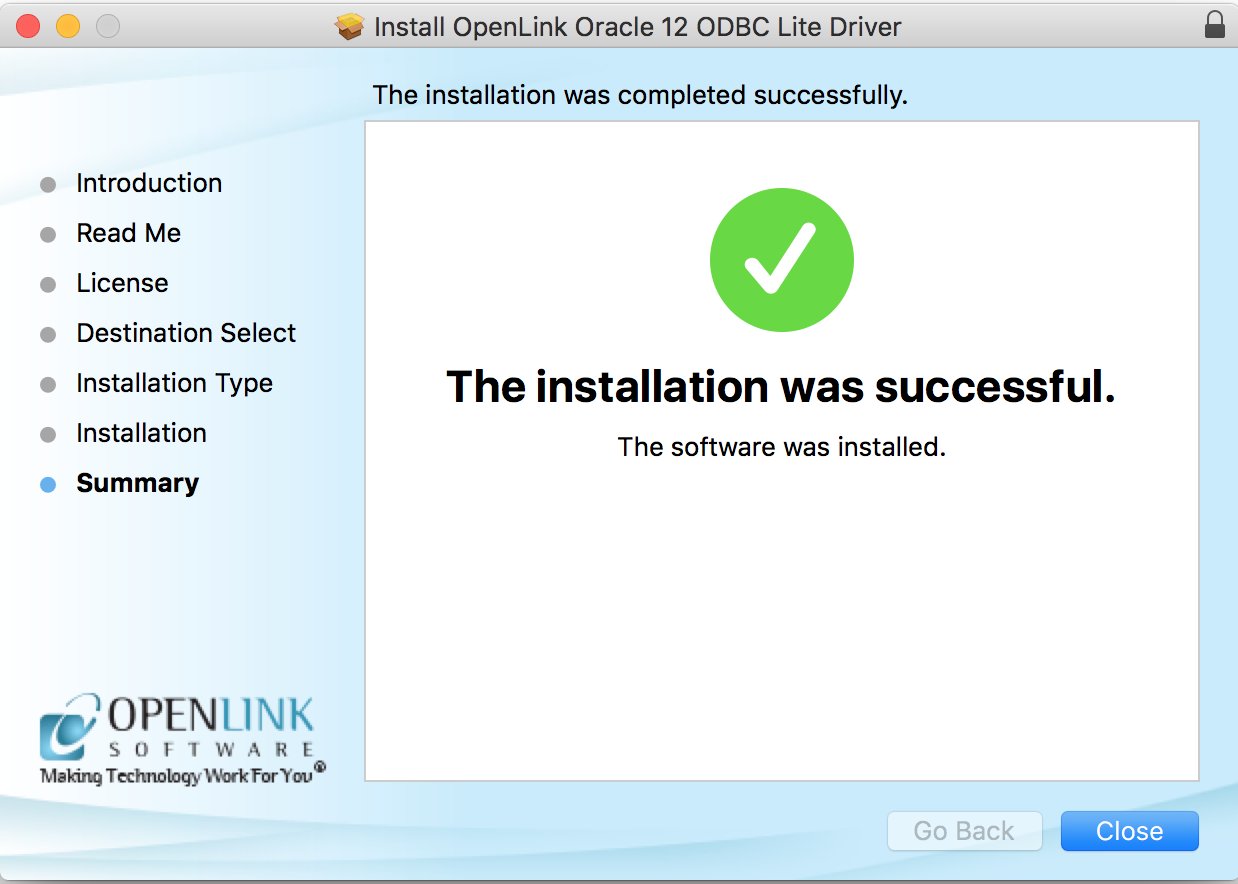
Configuration
- To configure an ODBC DSN, run the
OpenLink iODBC Administrator located in the /Applications/iODBC folder:

Note - Either the "iODBC Administrator" or "iODBC Administrator 64" programs can be used, as the driver is a "universal" bundle containing both a 32bit and 64bit driver as part of the single universal binary and the appropriate executable format will be loaded to match the program calling it.
- Click the System DSN tab:
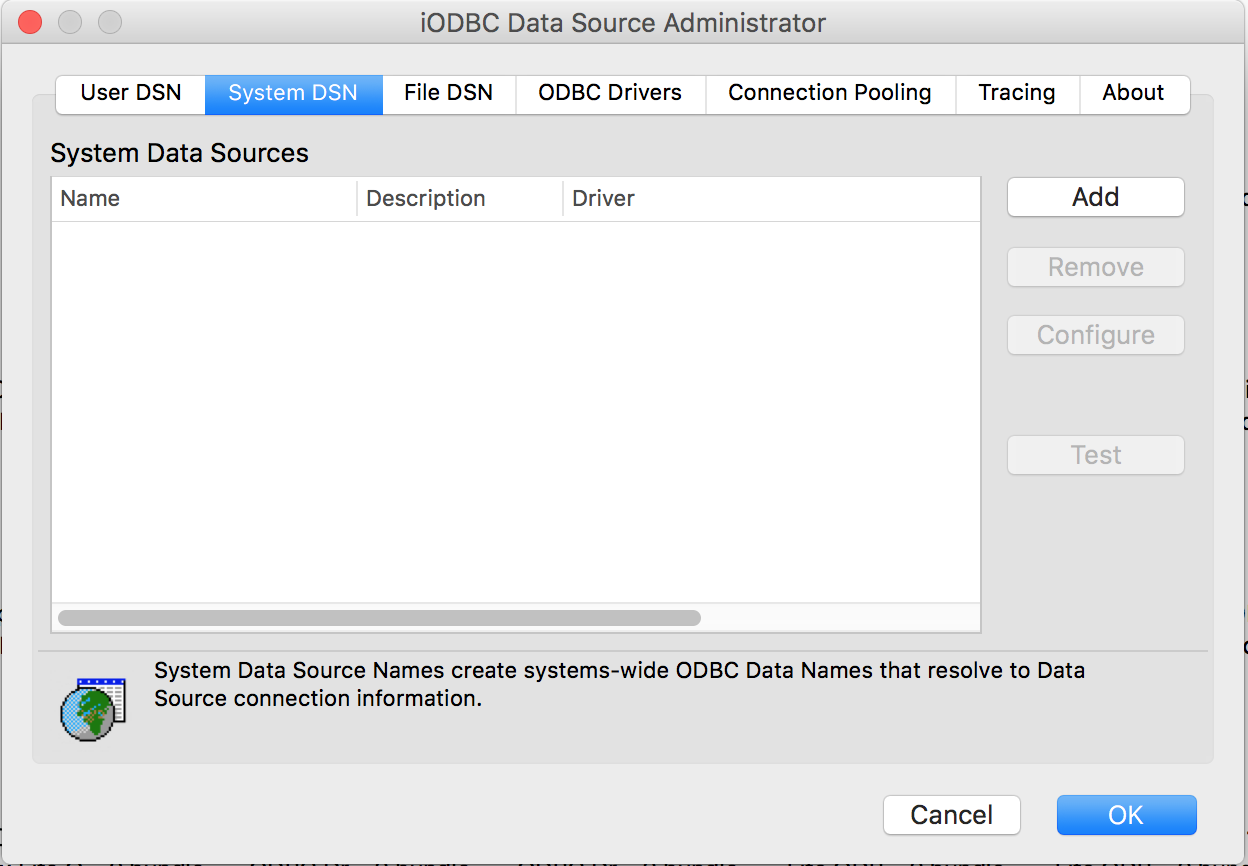
- Click the Add button.
Then, select the
OpenLink Oracle Lite Driver from the list of available drivers:
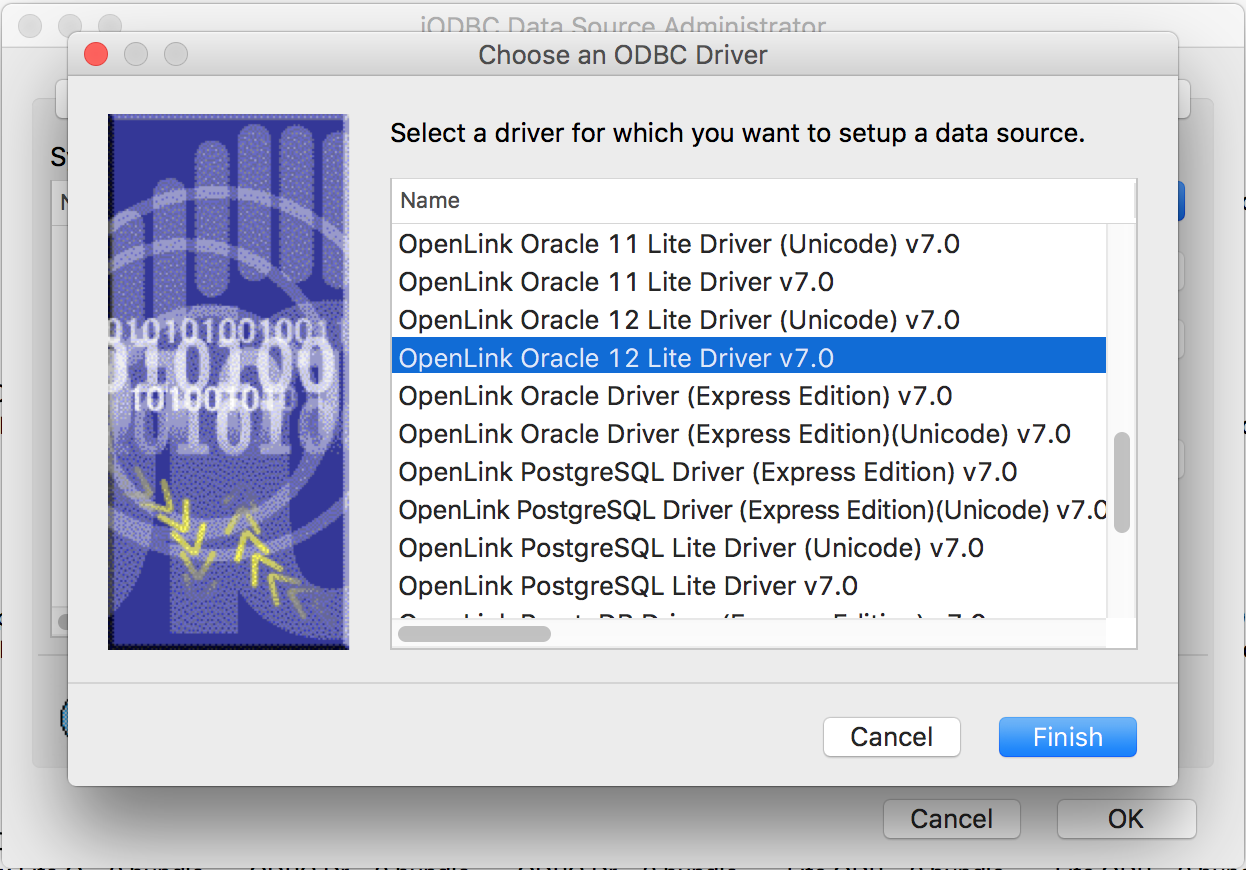
- Click Finish.
- The Data Source tab requests a name for your Data Source and you may also supply an optional description for your Data Source Name.
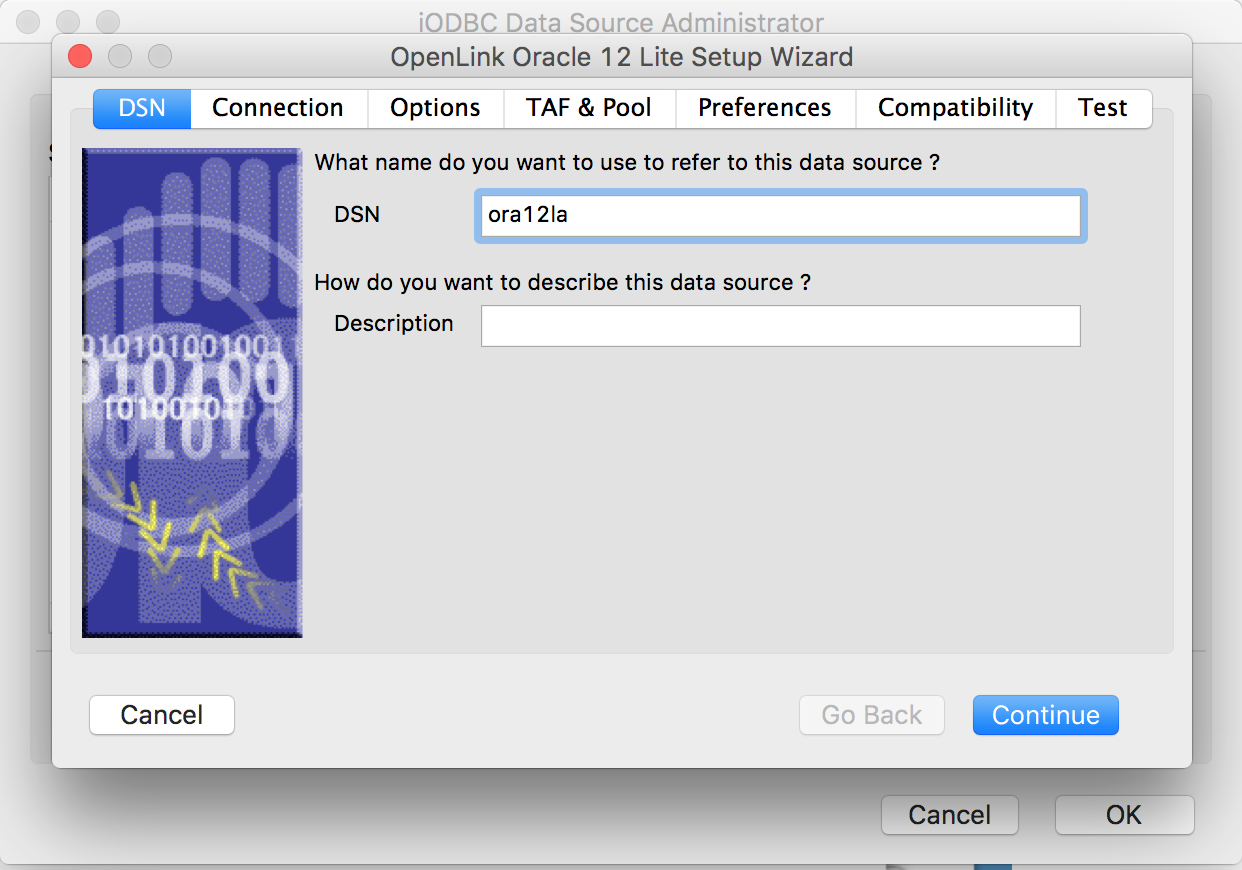
- DSN - A brief and meaningful title for your Data Source Name
- Description - An optional description for your Data Source Name
- DSN - A brief and meaningful title for your Data Source Name
- Click Continue.
- The Connection Tab prompts the required Hostname, Port Number and Service name of the target Oracle Database.
Along with the username and option password, which can be used to make a test connection to the database for verification of the parameters being passed when the "Connect now to verify all settings are correct" check box option is selected:
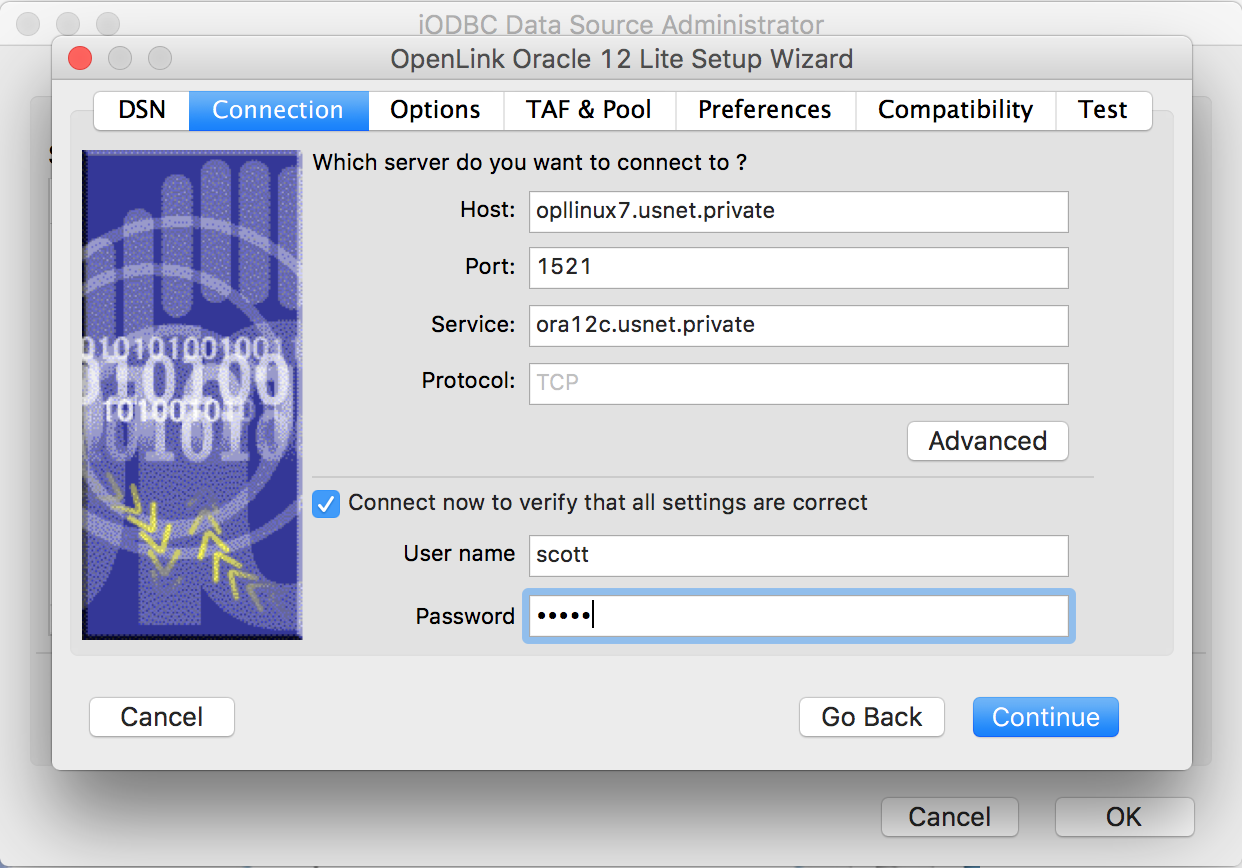
- Hostname - Hostname of the Oracle Database Server instance
- Port - Port Number the Oracle Database server is running (1521 by default)
- Service - Service name of the Oracle instance running on the Database Server connection require to
- Protocol - The network protocol to be used for connection, which is TCP by default
- Advanced - Enables addition Oracle Instant Client connection parameters to be passed if required

- User name - The user name to connect as
- Password - The password for the specified user
- Hostname - Hostname of the Oracle Database Server instance
- The Options Tab allows additional Oracle database and optional parameters to be passed:
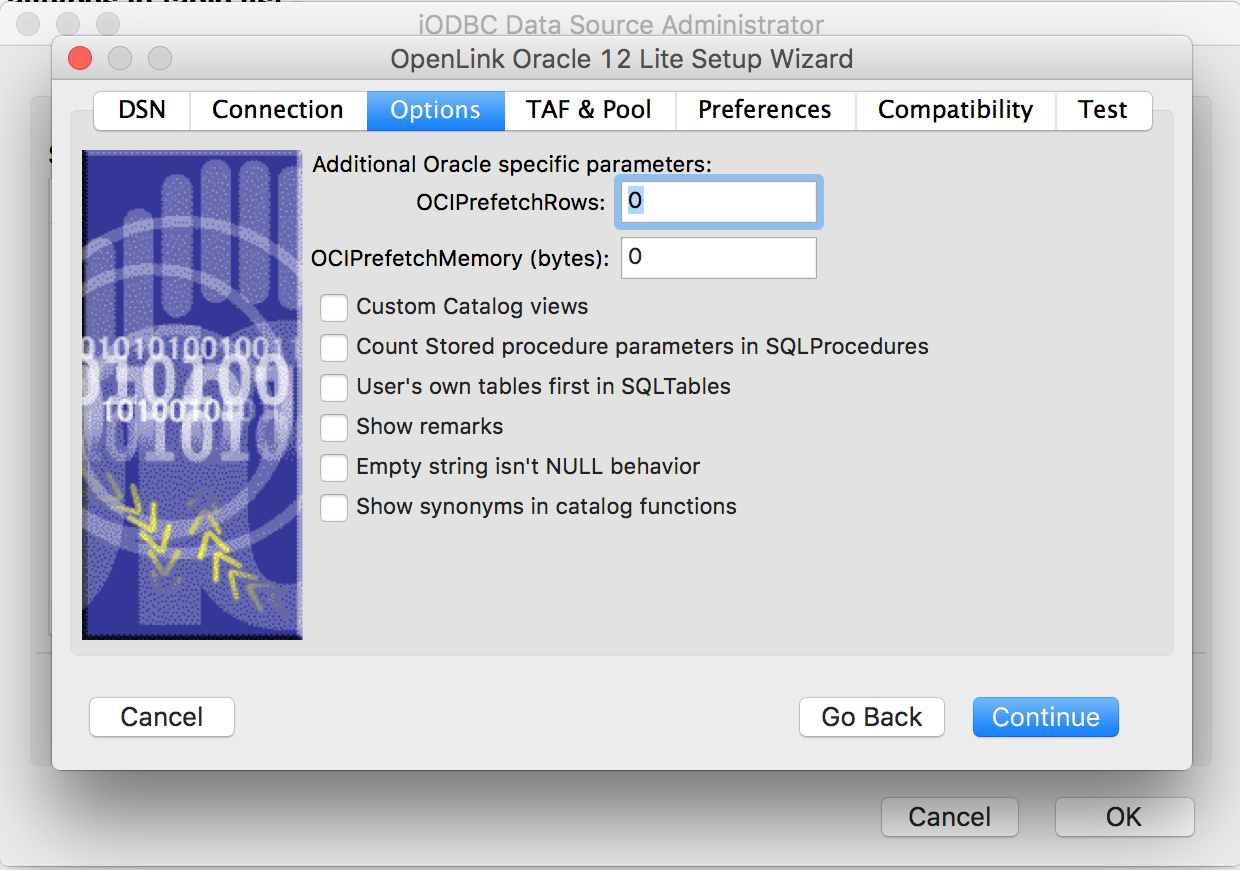
-
OCIPrefetchRows— Sets the number of rows to be prefetched. More
-
OCIPrefetchMemory — Sets the memory allocated for rows to be pre-fetched. The application then fetches as many rows as will fit into that much memory. More
- Custom Catalogue Views — Dictates whether custom
OpenLink views are used to return metadata for certain ODBC catalog functions: SQLForeignKeys(), SQLPrimaryKeys(), SQLProcedureColumns(), SQLProcedures(), and SQLSpecialColumns(). These custom views provide more metadata than is normally provided by the standard Oracle data dictionary views. More
- Count stored procedure parameters in SQL Procedures — This parameter is specific to the Oracle data source.
It affects the output from SQLProcedures() when "Custom Catalog Views" is enabled.
More
- User's own tables first in SQLTables — This option is specific to
OpenLink's Oracle drivers. It prompts the SQLTables() ODBC API call to display the connected user's tables first in table lists. The default ordering is alphabetical.
- Show remarks — Affects output from the SQLColumns() ODBC API call.
Use this option in conjunction with Oracle queries.
When enabled, the REMARKS column of a SQLColumns() result set includes the comments from the COMMENTS column of the Oracle ALL_COL_COMMENTS data dictionary view.
When disabled, the REMARKS column is empty.
Disabling Show Remarks improves performance.
- Empty string isn't NULL behavior — This parameter forces the driver to differentiate between an Empty string and a NULL, which Oracle does not do by default.
- Show synonyms in catalog functions — This parameter return Oracle Table Synonyms in Catalog calls like SQLTables().
-
- Click Next to continue.
- The TAF Tab enables you to set parameters specific to Transparent Application Failover:
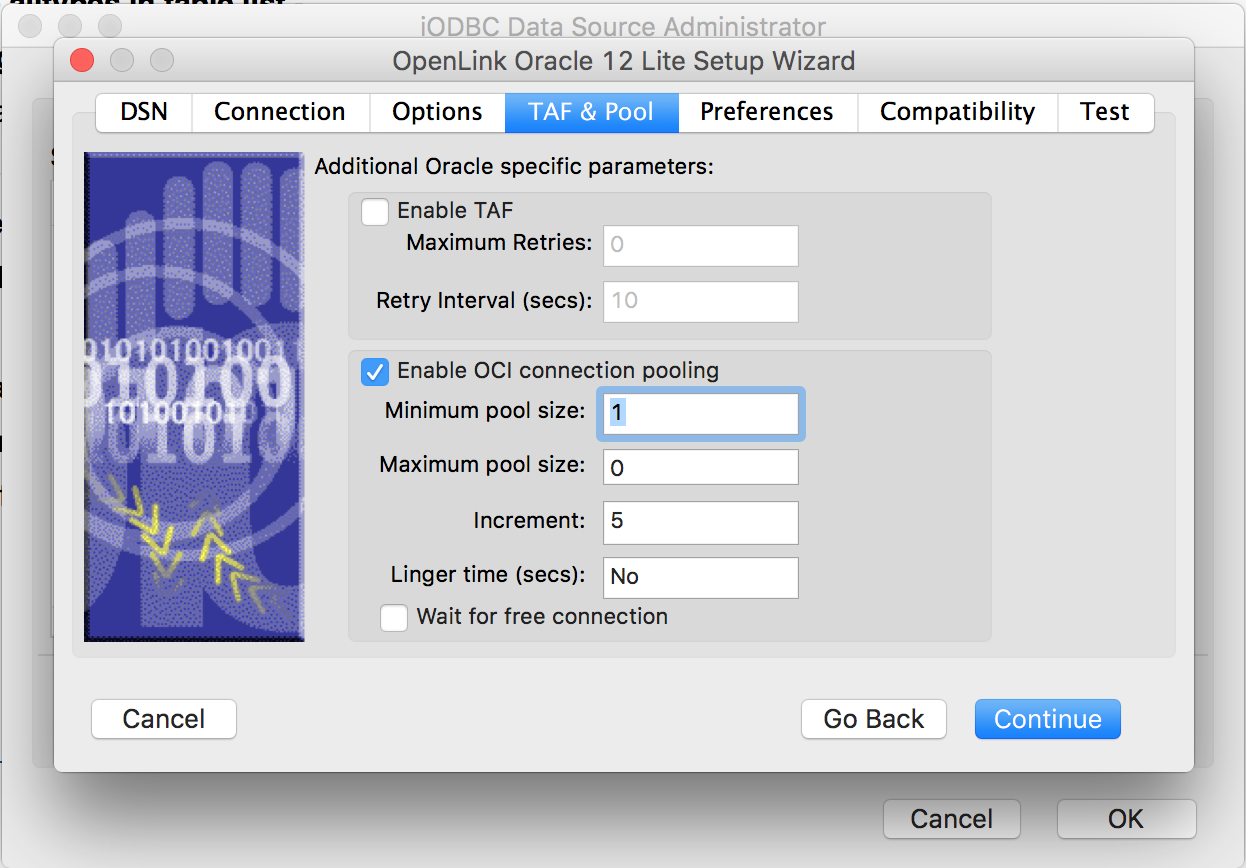
- Enable TAF — Instructs the driver to attempt multiple failover connections to alternative DBMS nodes per the Oracle TAF specification.
More
- Maximum Retries — The maximum number of times that the driver will retry the connection.
- Retry Interval (secs) — The number of seconds that the driver will wait between connection attempts.
- Enable OCI Connection Pooling — Check to create a separate connection pool for each Oracle instance to which you connect.
- Minimum Pool Size — The minimum number of connections to be opened when the pool is created.
- Maximum Pool Size — The maximum number of connections that can be opened in the pool.
- Increment — The incremental number of connections to be opened when all the connections are busy and a call needs a connection.
- Linger time — The amount of time to wait for a connection when all connections are busy and the maximum number of open connections has been reached.
- Wait for free connection — The length of time the last connection in the pool should linger before the pool is destroyed.
- Enable TAF — Instructs the driver to attempt multiple failover connections to alternative DBMS nodes per the Oracle TAF specification.
More
- Click Next to continue.
- The Preferences Tab enables you to set parameters specific to OCI Connection Pooling:
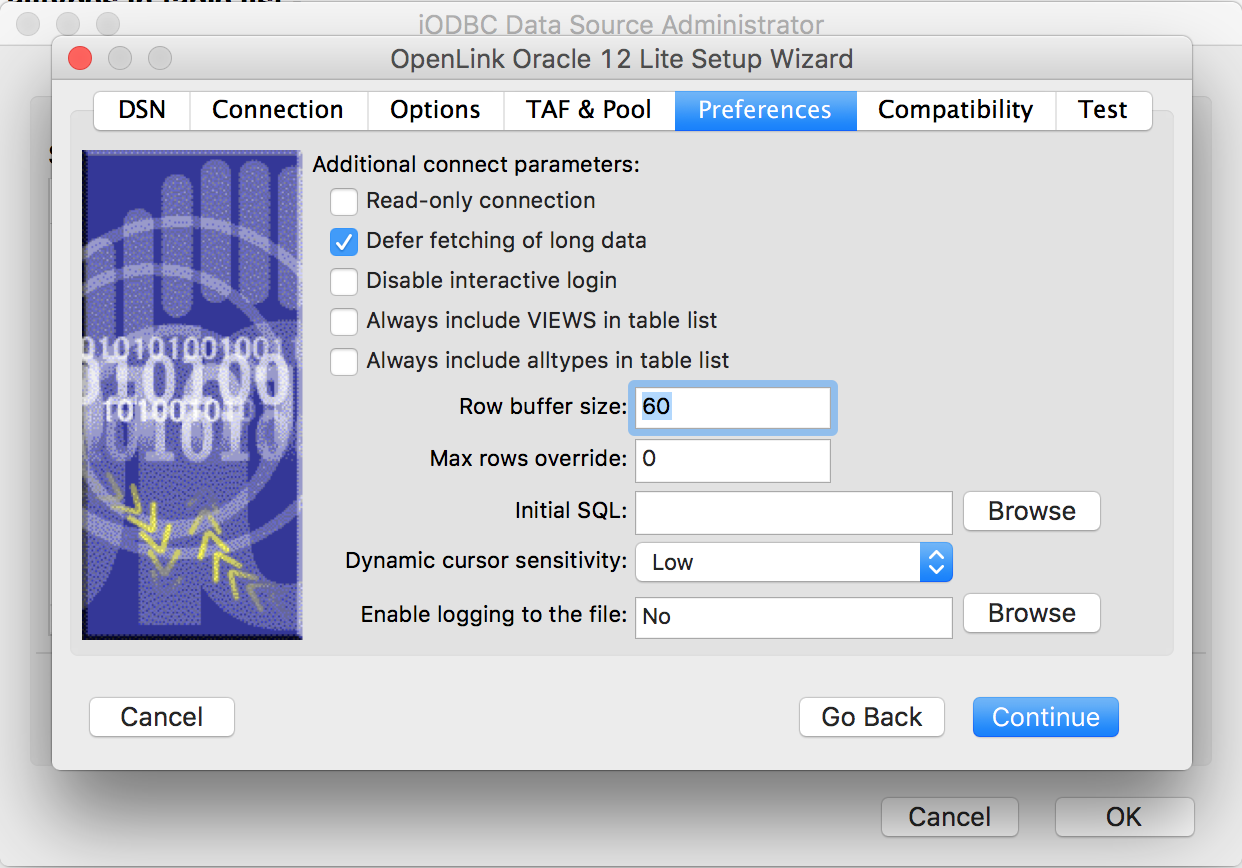
- Read-only connection — Specifies whether the connection is "Read-only." Must be unchecked to INSERT, UPDATE, or DELETE records, and to run some Stored Procedures including some built-in functions.
- Defer fetching of long data — Defers fetching of LONG (BINARY, BLOB, etc.) fields in wildcard queries.
This provides significant performance increases when fields in query do not include LONG data fields.
- Disable interactive login — Suppresses the ODBC "Username" and "Password" login dialog boxes when interacting with your ODBC DSN from within an ODBC compliant application.
- Row Buffer Size — This attribute specifies the number of records to be transported over the network in a single network hop.
Values can range from 1 to 999.
- Max rows Override — Allows you to set a limit for the maximum number of rows to be returned from a query.
The default value of 0 means no limit.
- Initial SQL — Lets you specify a file containing SQL statements that will be run automatically against the database upon connection.
- Dynamic Cursor Sensitivity — Enables or disables the row version cache used with dynamic cursors.
When dynamic cursor sensitivity is set high, the Cursor Library calculates checksums for each row in the current rowset and compares these with the checksums (if any) already stored in the row version cache for the same rows when fetched previously.
If the checksums differ for a row, the row has been updated since it was last fetched and the row status flag is set to SQL_ROW_UPDATED.
The row version cache is then updated with the latest checksums for the rowset.
From the user's point of view, the only visible difference between the two sensitivity settings is that a row status flag can never be set to SQL_ROW_UPDATED when the cursor sensitivity is low.
(The row status is instead displayed as SQL_ROW_SUCCESS.) In all other respects, performance aside, the two settings are the same.
Deleted rows don't appear in the rowset.
Updates to the row since the row was last fetched are reflected in the row data, and inserted rows appear in the rowset, if their keys fall within the span of the rowset.
If your application does not need to detect the row status SQL_ROW_UPDATED, you should leave the High Cursor Sensitivity checkbox unchecked, as performance is improved.
The calculation and comparison of checksums for each row fetched carries an overhead.
If this option is enabled, the table oplrvc must have been created beforehand using the appropriate script for the target database.
- Enable logging to the log file — Check the checkbox and use the associated textbox to provide the full path to a file in which to log diagnostic information.
- Read-only connection — Specifies whether the connection is "Read-only." Must be unchecked to INSERT, UPDATE, or DELETE records, and to run some Stored Procedures including some built-in functions.
- Click Next to continue.
- The Compatibility Tab enables you to set additional parameters to enhance compatibility with applications:
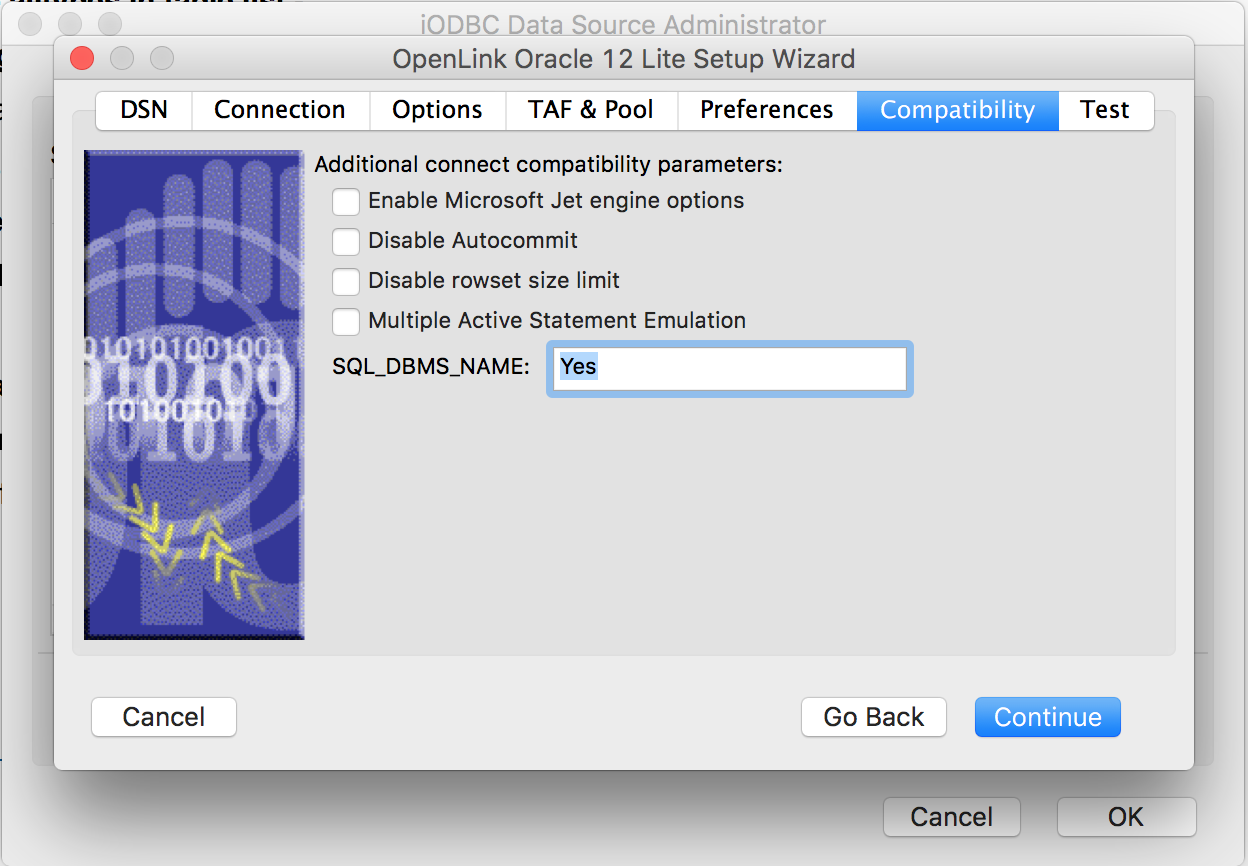
- Enable Microsoft Jet engine options — Facilitates translation of certain data types for the Microsoft Jet Engine.
If you notice that money and other datatypes are mishandled with Microsoft or other applications, test with Jet fix enabled.
- Disable
Autocommit — Changes the commit behavior of the OpenLink driver. The default mode is AutoCommit (box unchecked).
- Disable rowset size limit — Disables a limitation enforced by the cursor library.
This limitation is enforced by default.
It prevents the driver from claiming all available memory when a resultset (typically generated by an accidental query) is very large.
The limit is not normally reached.
- Multiple Active Statements Emulation — Enables use of Multiple Active statements in an ODBC application even if the underlying database does not allow this,, by emulation within the driver.
- SQL_DBMS Name — Manually overrides the
SQLGetInfo(SQL_DBMS_NAME) response returned by the driver. This is required for products like Microsoft InfoPath for which the value should be "SQL Server".
- Enable Microsoft Jet engine options — Facilitates translation of certain data types for the Microsoft Jet Engine.
If you notice that money and other datatypes are mishandled with Microsoft or other applications, test with Jet fix enabled.
- Click Next to continue.
- The Test Tab enables you to text your Data Source.
Click the Test Data Source button.
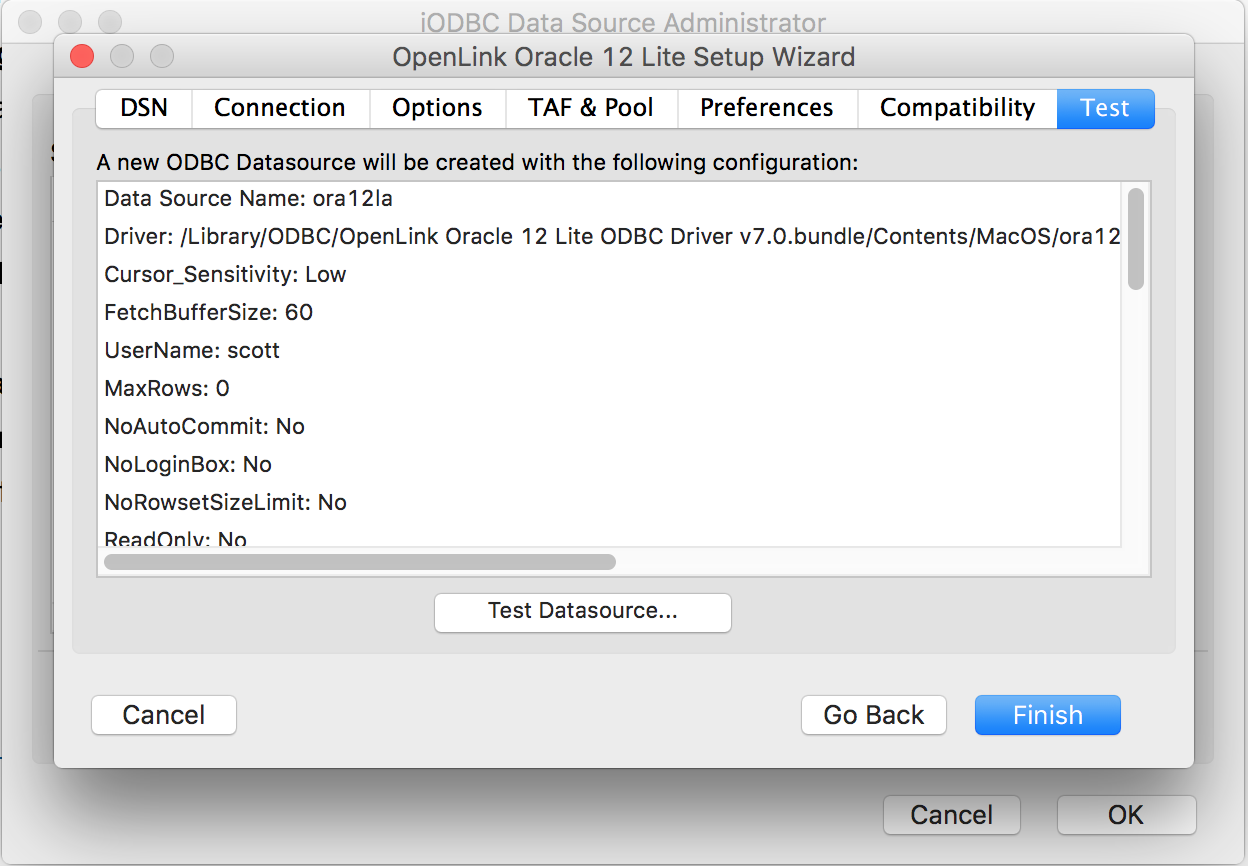
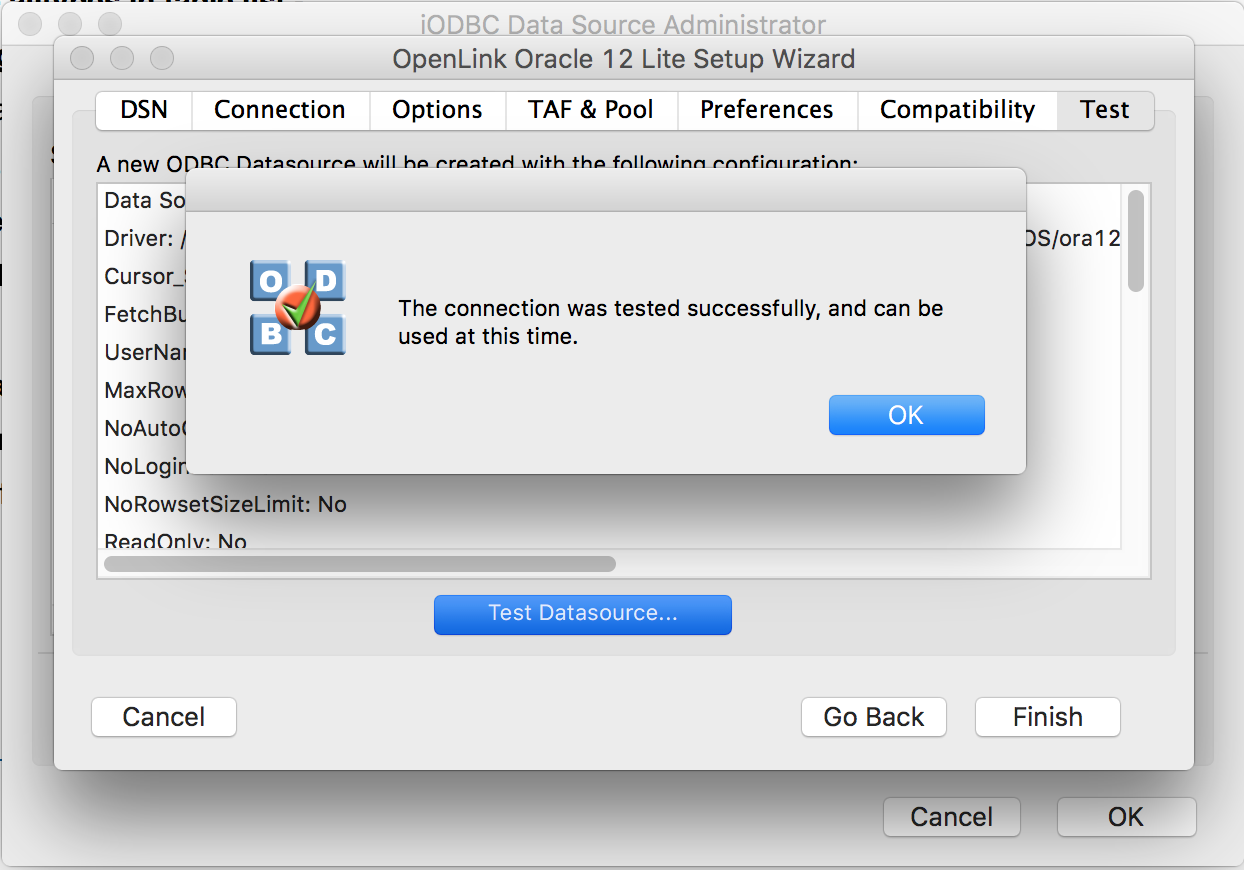
Next...
- Test your DSNs with our sample program.
- If anything isn't working as you expect, including errors resulting from the test above, see our Troubleshooting Resources.
- Should you decide to purchase a commercial license at the end of your evaluation period, be sure to consult our documentation which explains the placement and uptake of commercial license files and the use of our
OpenLink License Manager technology: License Technology & Application.
